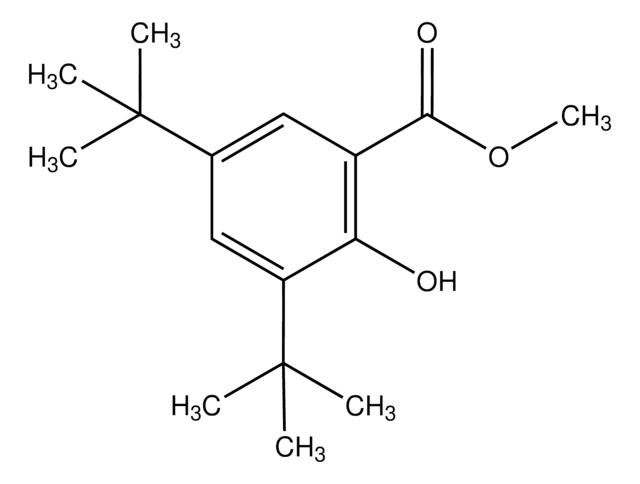Alle Fotos(3)
Wichtige Dokumente
132713
2,6-Dimethyl-4-nitrophenol
98%
Synonym(e):
4-Nitro-2,6-xylenol
Anmeldenzur Ansicht organisationsspezifischer und vertraglich vereinbarter Preise
Alle Fotos(3)
About This Item
Lineare Formel:
O2NC6H2(CH3)2OH
CAS-Nummer:
Molekulargewicht:
167.16
Beilstein:
1873275
EG-Nummer:
MDL-Nummer:
UNSPSC-Code:
12352100
PubChem Substanz-ID:
NACRES:
NA.22
Empfohlene Produkte
Assay
98%
mp (Schmelzpunkt)
168 °C (dec.) (lit.)
Funktionelle Gruppe
nitro
SMILES String
Cc1cc(cc(C)c1O)[N+]([O-])=O
InChI
1S/C8H9NO3/c1-5-3-7(9(11)12)4-6(2)8(5)10/h3-4,10H,1-2H3
InChIKey
FNORUNUDZNWQFF-UHFFFAOYSA-N
Suchen Sie nach ähnlichen Produkten? Aufrufen Leitfaden zum Produktvergleich
Anwendung
2,6-Dimethyl-4-nitrophenol was used to study the disposition requirement for binding of p-nitrophenol and sodium p-nitrophenolate like substrates with cyclohexaamylaose. It was used as internal standard in determination of 4-nitrophenol and 3-methyl-4-nitrophenol in human urine by liquid chromatography combined with tandem mass spectrometry .
Lagerklassenschlüssel
11 - Combustible Solids
WGK
WGK 3
Flammpunkt (°F)
Not applicable
Flammpunkt (°C)
Not applicable
Persönliche Schutzausrüstung
dust mask type N95 (US), Eyeshields, Gloves
Hier finden Sie alle aktuellen Versionen:
Besitzen Sie dieses Produkt bereits?
In der Dokumentenbibliothek finden Sie die Dokumentation zu den Produkten, die Sie kürzlich erworben haben.
Juan V Sancho et al.
Rapid communications in mass spectrometry : RCM, 16(7), 639-645 (2002-03-29)
The potential of liquid chromatography combined with tandem mass spectrometry (LC/MS/MS) for the determination of pesticide metabolites in human urine at the sub-ppb level is explored. Metabolites from two organophosphorous pesticides, 4-nitrophenol (from parathion and parathion-methyl) and 3-methyl-4-nitrophenol (from fenitrothion)
Disposition requirements for binding in aqueous solution of polar substrates in the cyclohexaamylose cavity.
Bergeron RJ, et al.
Journal of the American Chemical Society, 99(15), 5146-5151 (1977)
Tomohiro Ito et al.
Environmental science and pollution research international, 26(22), 22747-22755 (2019-06-07)
Secondary organic aerosol (SOA) is a component of airborne particulate matter in urban areas. However, their toxicities remain incompletely understood. In this study, we investigated the oxidative and inflammatory potency of SOA derived from three different volatile organic compounds (α-pinene
Unser Team von Wissenschaftlern verfügt über Erfahrung in allen Forschungsbereichen einschließlich Life Science, Materialwissenschaften, chemischer Synthese, Chromatographie, Analytik und vielen mehr..
Setzen Sie sich mit dem technischen Dienst in Verbindung.




![1,3-Dihydro-1,3,3-trimethylspiro[2H-indol-2,3′-[3H]naphth[2,1-b][1,4]oxazin] ≥98.0% (HPLC)](/deepweb/assets/sigmaaldrich/product/structures/328/450/b7868d16-ffb3-47c0-8c9b-81a9630a963a/640/b7868d16-ffb3-47c0-8c9b-81a9630a963a.png)



